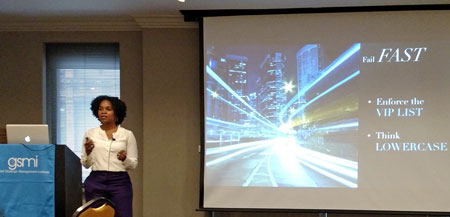At the 2016 Brand Strategy Conference, Antonia Dean, Director - Marketing, Brand Development, & Strategy at The Estée Lauder Companies covered the strategic thinking ideas behind creating an entrepreneurial environment in a large company. In her role, Antonia Dean focuses on incubating acquisitions and top-secret new product concepts.
The charge for Dean’s organization at ELC Ventures is to develop ideas to shake up Estee Lauder and the cosmetics industry. Moving as fast as the company’s fastest competitor demanded an entrepreneurial approach. Her experience has uncovered multiple ideas for how to create newness and build an entrepreneurial culture and spirit within an established parent organization.
16 Strategic Thinking Ideas for Creating an Entrepreneurial Environment Inside Your Company
Dean related her internal entrepreneurship (or “intrapreneurship”) lessons in three areas of strategic thinking: building the team, creating the culture, and defining success.
Building the Team
- The first step in team building is identifying the rights tasks requiring entrepreneurism. Not all business areas need or want an entrepreneurial approach and the upsides (and challenges) that come along with a cultural force that can run counter to the rest of the organization. If there is not an overwhelming upside to intrapreneurism, do not try to bring those functions into the team.
- Relative to specific team members, the successful entrepreneurs in an established organization are not necessarily the individuals the organization typically promotes because of following the rules. They are not the people achieving the longest tenure. The people you want in a start-up inside an established organization are always making up their own steps. They possess the talents, determination, and persistence that an organization cannot successfully constrain.
- A great way to check for an entrepreneurial attitude is to ask prospective team members if they believe in the internal start-up’s cause and what attracts them to it. Ask them to provide concrete examples of when they devised creative solutions.
- Intrapreneurs need their space in more ways than one. Not only do they need freedom from organizational policies and procedures, it is ideal to get them away physically from the rest of the organization. A separate office is ideal to provide greater latitude.
- Mix people up across departments and functions. You need to get the right combinations of people working together, not isolated within an area of functional expertise.
Creating the Culture
- Make it clear and entrepreneurial initiative within a bigger organization is completely different. It’s a great time to ask what about the parent organization was once positive but not persists without providing value or helping accelerate the entrepreneurial cause. Get rid of these things.
- When creating the new culture, think “lowercase b.” This is not BIG business with the standard procedures. Cultivate a fail fast AND fail cheap attitude. You need to be able to come up with ideas and launch them with little overhead and investment so you do not stick with a bad idea too long because of sunk costs.
- Enforce a VIP list, i.e., keep participation in the new venture exclusive. Do not let individuals from the main organization attach themselves or intrude unnecessarily, or you run the risk of slowing the entrepreneurial venture’s pace. Over-involving internal experts also leads to sanitizing ideas and adding unnecessary costs.
- Do not automatically copy your boss on emails about the entrepreneurial venture, just to be safe. Doing so simply takes up time for others and invites unnecessary activities.
- Extend and shape the culture by going out into the market to experience what is happening. It defeats the purpose to setup an intrapreneurial organization that does not bring in outside influences.
- Expect turnover in the team. When you are protecting the culture, people that do not fit will become apparent and be gone soon.
Defining Success
- Adopt the attitude of working “out of the basement.” A strong question to challenge significant resource requests is, “If we were starting this out of mom’s basement, would we spend this money?”
- Make friends with failure. Accept the bare minimum to move forward and be ready to “fail cheap.” Do not expect or demand perfection when you only need directional answers to be able to keep advancing with an idea or concept.
- Explicitly redefine success as something different from what success looks like in the parent organization. Put together the success recipe based on learning from failure and moving forward.
- Repeat this mantra: “Rocky failed, but Rocky won. Embrace failure as a given. WE ARE GOING TO FAIL AT SOMETHING.”
- Find and embrace the easy answers. You don’t know how to get a UPC code attached to a new product? Google for the answer instead of seeking out the internal expert. Not sure what the right marketing language is? Talk to your target consumers and see what words and phrases they use.
Antonia Dean’s strategic thinking ideas made it clear an entrepreneurial environment will not develop inside your company if you are too clingy to what has worked previously yet has grown stale and bloated. Start new, fresh, and lean, with a true appreciation for moving with speed, persistence, and a thick skin relative to failure! - Mike Brown
10 Keys to Engaging Employees to Improve Strategic Results
FREE Download: "Results!!! Creating Strategic Impact"
Leaders need high-impact ways to develop employees that can provide input into strategic planning and then turn it into results. This Brainzooming mini-book, "Results - Creating Strategic Impact" unveils ten proven lessons leaders can use to boost collaboration, meaningful strategic conversations, and results.
Download this free, action-focused mini-book to:
- Learn smart ways to separate strategic opportunities from the daily noise of business
- Increase focus for your team with productive strategy questions everyone can use
- Actively engage stakeholders in strategy AND implementation success






